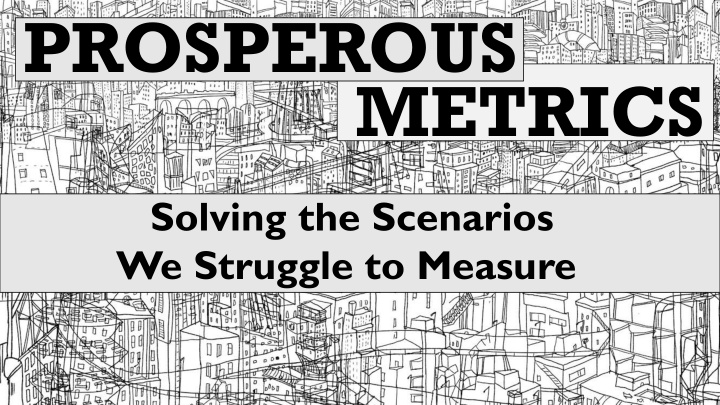



PROSPEROUS METRICS Solving the Scenarios We Struggle to Measure
Zach Bonaker @zachbonaker zbonaker@gmail.com agileoutloud.wordpress.com
“So, about those agile metrics I asked from you...”
“It is wrong to suppose that if you can’t measure it, you can’t manage it -- a costly myth.” W. Edwards Deming, The New Economics (P. 35)
A framework for “Prosperous Metrics” To Test: Improvement Metrics What decision? Systems Focused When no longer Likely Success Metric useful? need just one Long-term “Measure Up”
Scenario One “How can we show people are more productive?”
Productivity is a qualitative trap… … and quantitatively easy to grasp. Yet, maddingly invisible and (perceivably) inefficient. (for knowledge work, like software development)
“To make knowledge work productive will be the great management task of this century. ”
Any measure we use in the name of productivity must be a proxy to what really matters: *effectiveness. Period. *as it relates to process, not product.
Measuring Successful Effectiveness LEAD TIME
Measuring Improved Effectiveness Cycle What decisions? Time Where is the delay? What does our delay cost? Are we focusing on the delay? What conditions? When the constraint changes. Lead Time = Cycle time * WIP (Little’s Law)
Measuring Improved Effectiveness Time to What decisions? Fix Build Are we going too fast? Is this sustainable? What is our “normal state”? What conditions? Until it’s no longer useful. E.g., fix in next working hour
Measuring Improved Effectiveness Done What decisions? Forecast Are we predictable? How much disruption occurs? Forecast Delta Are we too optimistic? What conditions? Until it’s no longer useful. The value is in the picture…
Forecast Delta
Measuring Improved Effectiveness What decisions? Ø:0:1 Do we have a closed loop? hold ship null What is our system of work? Are sprints valuable? What conditions? Until it’s no longer useful. The value is in the picture…
Ø:0:1 Fixed date, Ø Ø Ø Ø Ø Ø Ø Ø 1 Fixed scope Need help Ø Ø 1 Ø Ø 1 Ø Ø 1 slicing Let’s chat Ø 0 Ø 1 0 0 Ø Ø 1 with PO 1 1 1 1 1 1 1 1 1 Winning
Scenario Two “How do I know quality is improving?”
Via Tim Ottinger: Hard on systems. Soft on people. Start Here.
Quality is rich in qualitative info. Your story reveals quantitative needs.
Measuring Successful Quality FIRST TIME YIELD [Units Produced] – [Units Defective] [Units Produced] FTYa * FTYb … FTYn = FTYall
Measuring Improved Quality Ratio of features vs What decisions? technical Is this sustainable (cost)? What needs to change? risk What does the trend tell us? What conditions? T eam tells us they have time/space needed to maintain.
Measuring Improved Quality Automated What decisions? Test What is gained by improving? Coverage What would increase trust? What conditions? Our teams tell us they don’t fear refactoring code. The work to improve outweighs the perceived benefit.
Scenario Three “How can I see if transformation is happening?
Via Karen Ribback | KR Global Consulting It will be It will be better. different. Change Transform
The key to “measuring” transformation is seeing the difference
Measuring SuccessfulTransformation USE A PICTURE HOW?!
Transformation Sliders Description A Description B Numbers are A visual method is most important preferred for for transformation transformation Are we here?
Example: Scrum Guide Backlog items are scoped and No one tells team how to create solutioned for team. slices of releasable functionality. T eam members work according to No sub-teams, regardless of functional silo or sub-team. domain like testing or analysis.
Example: Agile Transformation Performance reviews emphasize Performance reviews emphasize the individual; discussion is annual. the team; discussion is ongoing. Managers with a tactical, problem- Managers intent upon creating a solving orientation. Manages 1:1. highly participative team.
Want the whole Scrum Guide in slider format? http://bit.ly/2vmTiwZ
Measuring ImprovedTransformation Let the picture guide you HOW?!
Force-Field Analysis Describe the desired state What is supporting? What is working against? Thing Thing Thing Thing Thing Thing What could we do to What would help this increase support? be less of a block?
Perspective Mapping Old Behavior New Behavior M T A A Old Behavior New Behavior T M B B Old Behavior New Behavior M T C C
MUST BE QUANTITATIVE
Zach’s Experimental Environment Metric #ppl(#ppl – 1) 2 Avg Rel Items #teams # Rel Items Done 1 + Depend. Median Safety < = 150 (a # from 1 to 5) (Dunbar’s Number)
1 MEASURE UP 2 SUCCESS METRIC 3 IMPROVEMENT METRICS
Productivity Quality i.e., Effectiveness! LEAD TIME FTY (First Time Yield) Cycle Time Be Qualitative First! Ratio: Feature - Defect Time to fix build Forecast delta Auto Test Coverage “the perceived benefit” null:0:1 Transformation PAINT A PICTURE, TELL A STORY Your picture will guide the way!
THANK YOU! Enjoy the rest of the show! @zachbonaker zbonaker@gmail.com agileoutloud.wordpress.com
Recommend
More recommend